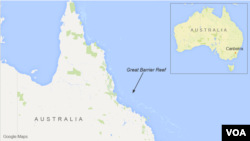Mass bleaching has destroyed more than a third of the northern and central sections of Australia's Great Barrier Reef, scientists said Monday.
It is the third -- and most extreme -- mass bleaching event in 18 years to affect the reef, said Terry Hughes, director of the ARC Centre of Excellence for Coral Reef Studies at James Cook University in Queensland state.
"We found on average, that 35 percent of the corals are now dead or dying on 84 reefs that we surveyed along the northern and central sections of the Great Barrier Reef, between Townsville and Papua New Guinea," Hughes said in a statement.
He and other experts blame global warming and El Nino, which raises temperatures in parts of the Pacific Ocean, for the mass bleaching events.
Warm water temperatures cause the coral to expel algae, which turns it white and robs it of an important food source. Bleaching also slows coral reproduction and growth rates, scientists said.
Coral is gone forever once it dies. If temperatures drop, however, the coral has a chance to recover.
"The current event is much more extreme than we've measured before," Hughes added.
In a months-long effort, researchers conducted underwater and aerial surveys of the 2,300 kilometer reef located off Australia's eastern coast.
The study found the southern reefs were largely spared from damage.
The Great Barrier Reef is a World Heritage Site that draws more than $3.5 billion in tourism to Australia each year.
A year ago, UNESCO's World Heritage Committee decided against placing the reef on its endangered list, but Monday's report may force the group to reconsider.
Coral reefs, made up of the bony skeletons excreted by polyps, are vital ecosystems in the world. They provide nurseries for nearly a quarter of the ocean's fisheries, according to the World Wildlife Fund. They also protect shorelines and wetlands along the coasts, according to the U.S. National Oceanic and Atmospheric Administration (NOAA).










